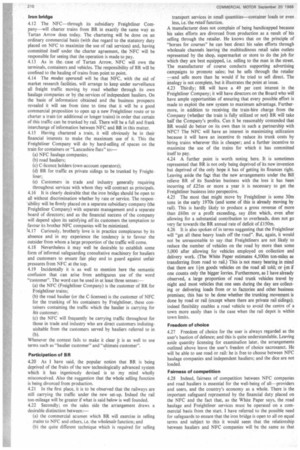Participation of BR
Page 214

If you've noticed an error in this article please click here to report it so we can fix it.
4.20 As I have said, the popular notion that BR is being deprived of the fruits of the new technologically advanced system which it has ingeniously devised is to my mind wholly misconceived. Also the suggestion that the whole selling function is being divorced from production.
4.21 In the first place, it is to be observed that the railways are still carrying the traffic under the new set-up. Indeed the rail ton-mileage will be greater if what is said below is well founded. 4.22 Secondly; on the sales side the arrangement draws a desirable distinction between:—
(a) the commercial acumen which BR will exercise in selling trains to NFC and others, i.e. the wholesale function; and (b) the quite different technique which is required for selling transport services in small quantities—container loads or even. less, i.e. the retail function.
A Manufacturer does not complain of being handicapped because his sales efforts are divorced from production as a result of his selling through the retailer. He knows that on the principle of "horses for courses" he can best direct his sales efforts through wholesale channels leaving the multitudinous retail sales outlets represented by the shop, supermarket or store to do the job for which they are best equipped, i.e. selling to the man in the street. The manufacturer of course conducts supporting advertising campaigns to promote sales; but he sells through the retailer =and sells more than he would if he tried to sell direct. The analogy is not complete, but it illustrates the point at issue.
4.23 Thirdly; BR will have a 49 per cent interest in the Freightliner Company; it will have directors on the Board who will have ample opportunities of ensuring that every possible effort is made to exploit the new system to maximum advantage. Furthermore, in addition to receiving the train-hire charge from the Company (whether the train is fully utilized or not) BR will take half the Company's profits. Can it be reasonably contended that BR would do better on its own than in such a partnership with NFC? The NFC will have an interest in maximizing utilization because it will have an incentive tb reduce its trunk costs by hiring trains wherever this is cheaper; and a further incentive to maximize the use of the trains for which it has committed itself to pay.
4.24 A further point is worth noting here. It is sometimes represented that BR is not only being deprived of its new invention but deprived of the only hope it has of getting its finances right. Leaving aside the fact that the new arrangements under the Bill relieve BR of its Sundries business with the loss it has been incurring of £25m or more a year it is necessary to get the Freightliner business into perspective.
4.25 The most that might move by Freightliner is some 30m tons in the early 1970s (and some of this is already moving by rail). This is hardly likely to produce a gross revenue of more than £60m or a profit exceeding, say £6m which, even after allowing for a substantial contribution to overheads, does not go very far towards the BR annual rate of deficit of £150m.
4.26 It is also spoken of in terms suggesting that the Freightliner will "get all these heavy loads off the road". But, again, it would not be unreasonable to say that Freightliners are not likely to reduce the number of vehicles on the road by more than some 5,000 after allowing for vehicles employed on collection and delivery work. (The White Paper estimates 4,500m ton-miles as transferring from road to rail.) This is not many bearing in mind that there are 14-rn goods vehicles on the road all told; or 4-rn if one counts only the bigger lorries. Furthermore, as I have already observed, a large proportion of road trunk vehicles travel by night and most vehicles that one sees during the day are collecting or delivering loads from or to factories and other business premises; this has to be done whether the blinking movement is done by road or rail (except where there are private rail sidings); indeed flexibility enables a road vehicle to avoid the centre of a town more easily than is the case when the rail depot is within town limits.


















































































































































































































































































































































































